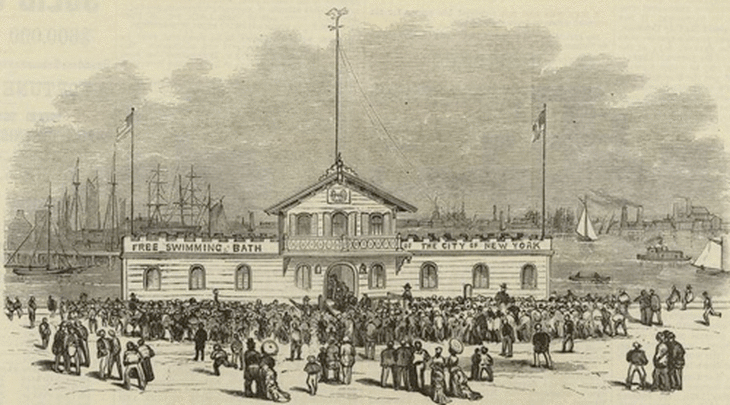New York: Art and Culture Capital of the Gilded Age
Today on Gotham, coordinating editor Katie Uva speaks to Margaret R. Laster and Chelsea Bruner, editors of New York: Art and Culture Capital of the Gilded Age.
Read MoreThe Metropolitan Section: City Life, Delivered
By Julia Guarneri
“I thought I knew every nook and angle of this village, but it seems your staff are ferreting out new and interesting bits every week.” In 1919, subscriber Charles Romm sent this letter to the New York Tribune, praising the paper’s new “In Our Town” section. The Tribune — like the World, the Times, the American, and many of the city’s other daily papers — had begun printing a special local section on Sundays. These metropolitan sections, as they were often called, did not print local news, exactly. They were not the places to look for accident reports or the latest in city politics. Instead, metropolitan sections gave readers glimpses of the everyday city. They brought the sights, accents, and clamor of the city into readers’ laps, to be enjoyed from a living room couch or a lunch counter. Newspapers’ metropolitan sections packaged up city life for quick, enjoyable consumption.
Erica Wagner's Chief Engineer: Washington Roebling, The Man Who Built the Brooklyn Bridge
Reviewed by Richard Howe
The name Roebling is so closely bound up with the Brooklyn Bridge that it’s probably worth saying at the outset of this review that Erica Wagner’s Chief Engineer: Washington Roebling: The Man Who Built the Brooklyn Bridge(Bloomsbury, 2017) really is a biography of the man and not — as might be said of David McCullough’s classic The Great Bridge (Simon & Schuster, 1972) — a biography of the bridge. The eldest son of the bridge’s designer and promoter, John A. Roebling, Washington Roebling was born on May 26, 1837, in Saxonburg, Pennsylvania, and died shortly past his eighty-ninth birthday, on July 21, 1926, in Trenton, New Jersey. He served as chief engineer for the construction of what was then known as the East River Bridge for nearly fourteen years, from shortly after his father’s death on July 22, 1869, until he resigned the position not long after the bridge was opened to the public on May 24, 1883 (his assistant C. C. Martin was appointed in his place on July 9, 1883). Washington Roebling was thirty-two when he was appointed chief engineer for the Brooklyn Bridge; he lived another forty-three years after leaving that post. Though it was his position with the bridge project that secured him a place in the history of New York, seventy-five of his eighty-nine years were not spent on the great bridge, and it is perhaps the greatest merit of Erica Wagner’s book that it would be a fascinating and moving read even if its subject had never been chief engineer of the Brooklyn Bridge. I would almost go so far as to say that it might have been an even more fascinating and moving read had he not been.
Read MoreThe Gould Memorial Library: A Forgotten Stanford White Gem in the Bronx
By Elizabeth Macaulay-Lewis
The Gould Memorial Library in the Bronx may be the most famous building in New York City that you’ve never heard of. It recently made an appearance in The Greatest Showman, the 2018 Hugh Jackman musical about the life of P. T. Barnum, as the setting for a glorious party, but unless you know what you’re looking at, you’d think it was an elaborate Hollywood stage set—not a library.
Read MoreThe Earliest Sculptures in Central Park
By Dianne Durante
In Olmsted and Vaux’s Greensward Plan, the only sculpture was one atop the fountain at the center of Bethesda Terrace. The commission for the sculpture was given in 1863 to Emma Stebbins (1815-1882), an American-born sculptor working in Rome who happened to be the sister of a member of the Board of Commissioners of Central Park.
This post is an excerpt from the author's new book, Central Park: The Early Years.
Read More"Out of ashes comes beauty": An interview with Jeffrey C. Stewart
Today on Gotham, Peter-Christian Aigner speaks with Jeffrey C. Stewart about his new book, The New Negro: The Life of Alain Locke, the most comprehensive biography on the "father of the Harlem Renaissance."
Read MoreAmy Werbel's Lust on Trial: Censorship and the Rise of American Obscenity in the Age of Anthony Comstock
Reviewed by Marcela Micucci
Anthony Comstock was a household name in nineteenth-century America, so much so that his last name became synonymous with a movement and set of laws that sought to censor obscenity and eradicate vice. Historian Amy Werbel explores this anti-obscenity movement — and its champion — in her provocative and cutting-edge work, Lust on Trial: Censorship and the Rise of American Obscenity in the Age of Anthony Comstock (2018).
Read MoreA "Madhouse in all its Naked Ugliness and Horror": An Interview with Stacy Horn
Today on Gotham, associate editor David Thomson speaks with Stacy Horn, author of the new book Damnation Island: Poor, Sick, Mad & Criminal in 19th Century New York, about the dark history of Blackwell's Island, known more commonly today as Roosevelt Island.
Read MoreRivers, Filth and Heat: Riverbaths and the Fight over Public Bathing
By Naomi Adiv
In the summer of 1870, New York City got its first municipal bath: swimming pools sunk into the rivers, through which river water flowed. An 1871 New York Times article describes them: “baths are of the usual house-like model, and have a swimming area of eighty-five feet in length by sixty-five feet in width. They are… provided with sixty-eight dressing-rooms, have offices and rooms in an additional story, and are well lighted with gas for night bathing.” In the year after they were built, the Department of Public Works reported that they were regularly used to their capacity, particularly on hot summer days. At their height, there were twenty-two such baths around the waters of New York City.
Read More









